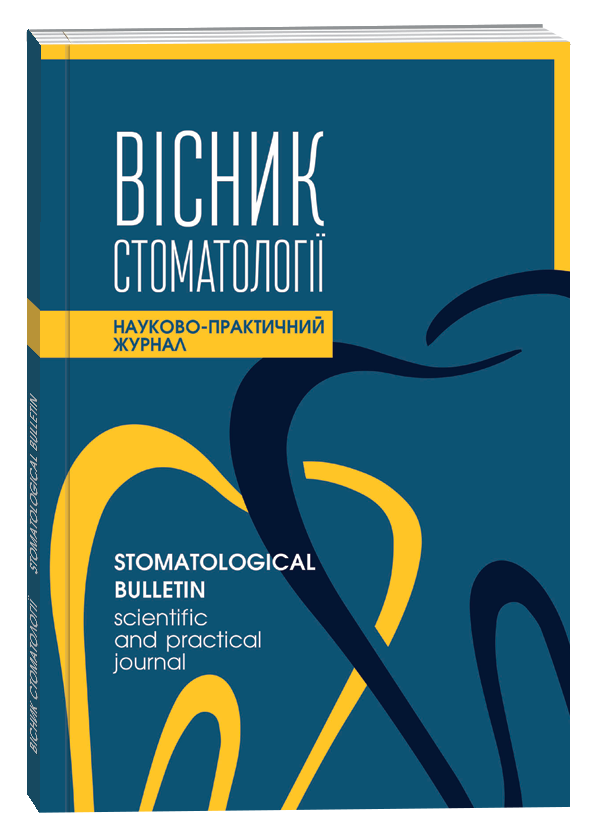PREVALENCE, CLINICAL FEATURES AND TREATMENT ALGORITM OF PATIENTS WITH DRUG-INDUCED GINGIVAL ENLARGEMENT
DOI:
https://doi.org/10.35220/2078-8916-2022-44-2.18Keywords:
drug-induced gingival enlargement, periodontitis, phenytoin, сyclosporine, nifedipine, аmlodipineAbstract
Some pharmacological drugs, with constant daily use, can cause a side effect in humans such as gingival enlargements. These include: anticonvulsants (phenytoin), immunosuppressors (cyclosporine, tacrolimus, azathioprine), calcium tubule blockers from the group of antihypertensive agents (nifedipine, amlodipine, lercanidipine, etc.). In the new International Classification of periodontal and peri-implant diseases and conditions (AAP&EFP, Chicago, 2017) the nosological form "drug-influenced gingival enlargements" is included in a separate subsection C to paragraph 2 "Gingivitis – dental biofilm-induced” of I group “Periodontal health, gingival diseases/conditions". Purpose of the study. To determine the clinical features and the treatment tactics of patients with drug-influenced gingival enlargements. Methods. 28 patients (17 men, 11 women) at the age of 24-73 years with drug-influenced gingival enlargements were examined. Clinical, radiological and laboratory tests were conducted. Results. It was found that more often drug-influenced gingival enlargements occurs in men (60.7%). Periodontitis of varying degrees has been diagnosed in all patients with gingival hyperplasia in various somatic pathologies. 3 persons with druginfluenced gingival enlargements accepted fenitoin, 2 persons after kidney transplant surgery – сyclosporine and 23 patients (82,1%) with grade II-III hypertensive disease accepted calcium channel blockers (nifedipine, amlodipine, lercanidipine). Among drugs most often causes side effect in the gingival enlargement аmlodipine (at 17 people, 60,7%). It is shown that the drug-induced gingival enlargement contributes to a more severe course of periodontitis, which requires clarification of treatment protocols. All patients with drug-induced gingival enlargement received conservative therapy, which included: scaling, air-abrasive polishing, topical antimicrobial (0.12% chlorhexidine) and antiinflammatory (benzydamine hydrochloride) therapy. In 14 patients, a course of photodynamic therapy was additionally performed. All patients were trained in individual hygiene and recommended oral care products. Conclusions. Treatment algorithm of patients with the drug-induced gingival enlargement is proved.
References
Moffitt M.L., Bencivenni D., Cohen R.E. Druginduced gingival enlargement: an overview. Compend Contin Educ Dent. 2013. Vol. 34, N. 5. P. 330-336.
Caton J.G., Armitage G., Berglundh T. et al. A new classification scheme for periodontal and peri-implant diseases and conditions –Introduction and key changes from the 1999 classification. J Periodontol. 2018. Vol. 89. P. S1-S8.
Murakami S., Mealey B.L., Mariotti A., Chapple I.L. Dental plaque-induced gingival conditions. J Clin Periodont. 2018. Vol. 45. P. S17-S27.
Bondon-Guitton EE, Bagheri H, Montastruc J-L. Drug-induced gingival overgrowth: a study in the French Pharmacovigilance Database. J Clin Periodont. 2012. Vol. 39, N. 6. P. 513-518.
Brown R.S., Arany P.R. Mechanism of drug-induced gingival overgrowth revisited: a unifying hypothesis. Oral Dis. 2015. Vol. 21, N. 1. P. e51-e61.
Trackman P.C., Kantarci A. Molecular and clinical aspects of drug-induced gingival overgrowth. J Dent Res. 2015. Vol. 94, N. 4. P. 540-546.
Lauritano D., Lucchese A., Di Stasio D. et al. Molecular aspects of drug-induced gingival overgrowth: an in vitro study on amlodipine and gingival fibroblasts. Int J Mol Sci. 2019. Vol. 20, N. 8. P. 2047.
Kim S.S., Jackson-Boeters L., Darling M.R. et al. Nifedipine induces periostin expression in gingival fibroblasts through TGF-beta. J Dent Res. 2013. Vol. XX(X). P. 1-7.
Chung Y., Fu E., Chin Y.-T. et al. Role of Shh and TGF in cyclosporine-enhanced expression of collagen and a-SMA by gingival fibroblast. J Clin Periodont. 2015. Vol. 42. P. 29-36.
Seymour R.A., Elvlis J.S., Thomason J.M. Risk factors for drug-induced gingival overgrowth. J Clin Periodont. 2000. Vol. 27. P. 217-223.
Fardal Ø., Lygre H. Management of periodontal disease in patients using calcium channel blockers-gingival overgrowth, prescribed medications, treatment responses and added treatment costs. J Clin Periodont. 2015. Vol. 42, N. 7. P. 640-646.









